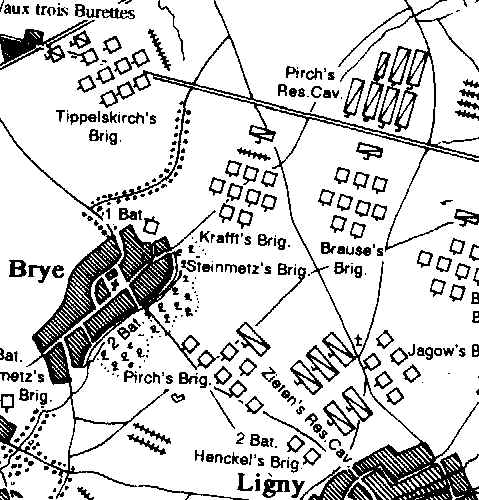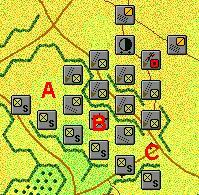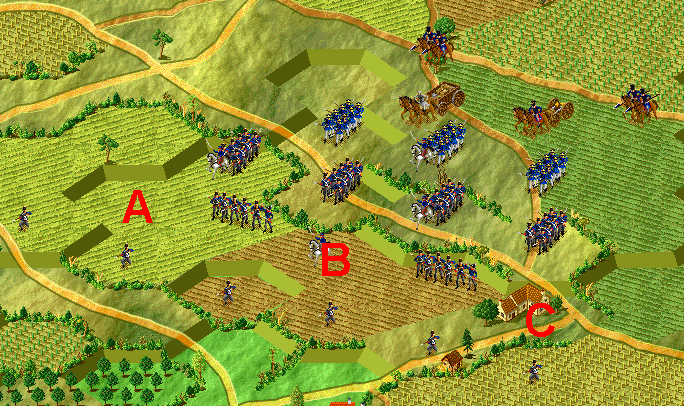|
|
|
Prussian brigade deployment, 1812-15
The BG optional rule 'Flank morale modifiers' and 'rout limiting' have been used widely, though as has been pointed out, their true implications have been underestimated. The fact that a unit might gain some confidence from having its flanks covered by adjacent units, along with being in a given situation with someone so immediately ready to share whatever the enemy is threatening, should not be overlooked. In BG terms, however, the optional rules when used together are more than these phenomena should warrant and the best result for a unit without open flanks is just that fact: there are no open flanks and its position is safer. Adding morale modifiers can produce brigades of superior units because the morale increments are too large to allow a realistic bonus from just being in formation - which is the situation they should be in anyway.
It has been suggested that these effects can be avoided by placing units in stacks with empty hexes between each stack, any contiguous units forming a 'crowd' rather than a formation. If three columns can fire out of a hex, this begs the question of why three units in one hex (obviously side by side if shooting together) are not a crowd when three units in adjacent hexes are. The conclusion that one is a crowd and one is not seems to be drawn from the optional rules' effects rather than the true positions of the units. I propose that the way to avoid the effects of the optional rules is to leave them out of the game. This will allow more accurate deployments as evinced by the following study.
How do side by side as opposed to separated stacks relate to troops' dispositions, both in the tactical theory and practice of the time? Here we will look at the disposition of Prussian brigades according to the regulations of 1812 and as put into effect at Ligny. Then we can see how best to place units on the BG field and, knowing how the rules affect them, see why these optional rules are best not used.
The Prussian 1812 brigade formation
 This diagram shows the text
book solution to deploying a 9 battalion Prussian brigade. The model layout is transferable
from brigade to brigade of varying strengths, as we shall see.
This diagram shows the text
book solution to deploying a 9 battalion Prussian brigade. The model layout is transferable
from brigade to brigade of varying strengths, as we shall see.
The frontage for a battalion 800 strong, in four companies of three ranks, would be 800 ÷ 12 x 0.6m (2' per man), or 40m. With intervals we can call this 50m maximum, proportionately less for weaker units. So our three unit fire capability from one hex would be stretched by full strength battalions and only two should really be able to shoot on a 100m frontage. In fact the deployment shows intervals of battalion frontage, making each unit with its adjacent interval 80-100m, or one hex wide.
The depth of a battalion, at 12 ranks plus company intervals, could be as little as 25m. Added to the prescribed 150m depth interval between units, more than one battalion per hex is beyond the limit in depth as well as breadth. All this is of course text book regulations, and who ever followed those in the face of battle? Well, it rather looks as though the Prussians did for a start.
Deployment in practice
 At Ligny (part of which is
shown at left), the layout of many brigades seems to have been both uniform and largely in
accordance with the regulations. Allowance would always be made for terrain, though by
preference the terrain would be chosen to allow a full deployment as far as possible.
While there is always the question of the map maker's interpretation of the location of
each battalion, this map does give a good impression of how the regulation layout would
have looked at least in general terms. Eye witness description of the brigade deployments
confirms the 2-4-3 battalion lines as shown on the map.
At Ligny (part of which is
shown at left), the layout of many brigades seems to have been both uniform and largely in
accordance with the regulations. Allowance would always be made for terrain, though by
preference the terrain would be chosen to allow a full deployment as far as possible.
While there is always the question of the map maker's interpretation of the location of
each battalion, this map does give a good impression of how the regulation layout would
have looked at least in general terms. Eye witness description of the brigade deployments
confirms the 2-4-3 battalion lines as shown on the map.
Krafft's and Brause's brigades, in reserve, are each shown in this classic deployment, two fusilier battalions to the fore, cavalry and guns to the rear. Tippelskirch's brigade is similarly deployed, though slightly skewed and with its cavalry on its right flank. The shape of Pirch's brigade can be seen to fit more with the frontage available and, being nearer the front line, its linear deployment may have been an effort to minimize the effects of enemy fire.
The scale of the map indicates a frontage and depth of somewhat less than 100m per battalion, though again some caution should be exercised as map makers are fond of showing battalion columns as neat squares. Even so, the frontage is not incompatible with units of some 800 men in columns. The intervals between units would have to be about as small as those shown in order for the number of units to fit the ground, so although a little diagrammatic the map gives a good idea of brigade deployments at Ligny.
Fitting reality to the hex grid
 Given that the theoretical and
practical deployments are proven, it is a simple task to fit both to the hexagonal grid of
the BG terrain. As these 2D and 3D views of the same brigade show, it at once appears that
the idea of stacked columns separated by empty hexes is not only unnecessary but is in
fact difficult to conform to. Rather it is a group of contiguous hexagons, each containing
one unit, which best accommodates the brigade formation of 9 battalions. Also, this
indicates that increasing the frontage would be the most accurate way of deploying more
battalions in larger formations.
Given that the theoretical and
practical deployments are proven, it is a simple task to fit both to the hexagonal grid of
the BG terrain. As these 2D and 3D views of the same brigade show, it at once appears that
the idea of stacked columns separated by empty hexes is not only unnecessary but is in
fact difficult to conform to. Rather it is a group of contiguous hexagons, each containing
one unit, which best accommodates the brigade formation of 9 battalions. Also, this
indicates that increasing the frontage would be the most accurate way of deploying more
battalions in larger formations.
The skirmishers would need to occupy at least 4 hexes in order to screen the front of the brigade. The remainder of the fusilier battalions are in line behind this screen and leading the rest of the brigade, which is in columns. The cavalry might deploy on either flank or in the rear ready to move in the direction where they are most needed. The brigade artillery could move through the formation to positions at A, B or C for direct fire support with fields of fire unhindered by the leading formed units.

In view of the fact that such a brigade formation requires units to be aligned, three and four abreast, in adjacent hexes, the optional rules on morale and rout limiting are not appropriate. They should not be used if realistic formations and their operation are to be reflected in the game.
Back to the infantry tactics page